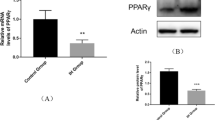Summary
Endothelial dysfunction induced by intermittent hypoxia (IH) participates in obstructive sleep apnea syndrome (OSAS)-associated cardiovascular disorders. Myeloid differentiation primary response 88 (MyD88) and tumor necrosis factor receptor-associated factor 6 (TRAF6) regulate numerous downstream adaptors like mitogen-activated protein kinases (MAPKs) and the subsequent oxidative stress and inflammatory responses. This study aimed to characterize the role of MyD88/TRAF6 in IH-treated cell function and its associated signaling. Human umbilical vein endothelial cells (HUVECs) were randomly exposed to IH or normoxia for 0, 2, 4 and 6 h. Western blotting was used to detect the expression pattern of target gene proteins [angiotensin 1 receptor (AT1R), p-ERK1/2, p-p38MAPK, MyD88 and TRAF6], and the relationships among these target genes down-regulated by the corresponding inhibitors were studied. Finally, the influence of these target genes on proliferation of HUVECs was also assessed by EdU analysis. Protein levels of AT1R, TRAF6 and p-ERK1/2 were increased after IH exposure, with a slight rise in MyD88 and a dynamic change in p-p38MAPK. The down-regulation of TRAF6 by siRNA reduced ERK1/2 phosphorylation during IH without any effects on AT1R. Blockade of AT1R with valsartan decreased TRAF6 and p-ERK1/2 protein expression after IH exposure. ERK1/2 inhibition with PD98059 suppressed only AT1R expression. IH promoted HUVECs proliferation, which was significantly suppressed by the inhibition of TRAF6, AT1R and ERK1/2. The findings demonstrate that TRAF6 regulates the proliferation of HUVECs exposed to short-term IH by modulating cell signaling involving ERK1/2 downstream of AT1R. Targeting the AT1R-TRAF6-p-ERK1/2 signaling pathway might be helpful in restoring endothelial function.
Similar content being viewed by others
References
Lurie A. Cardiovascular disorders associated with obstructive sleep apnea. Adv Cardiol, 2011,46:197–266
Feng J, Zhang D, Chen B. Endothelial mechanisms of endothelial dysfunction in patients with obstructive sleep apnea. Sleep Breath, 2012,16(2):283–294
Greenberg H, Ye X, Wilson D, et al. Chronic intermittent hypoxia activates nuclear factor-kappaB in cardiovascular tissues in vivo. Biochem Biophys Res Commun, 2006,343(2):591–596
Lavie L. Oxidative stress inflammation and endothelial dysfunction in obstructive sleep apnea. Front Biosci, 2012,4:1391–14030
Xie P. TRAF molecules in cell signaling and in human diseases. J Mol Signal, 2013,8(1):7
Thomas R. The TRAF6-NF kappa B signaling pathway in autoimmunity: not just inflammation. Arthritis Res Ther, 2005,7(4):170–173
Shang J, Yang YY, Guo XL, et al. Ang II type 1 receptor expression in rat aorta exposed to chronic intermittent hypoxia: effects of p38MAPK and ERK1/2 signaling. Chin Med J (Engl), 2013,126(17):3264–3269
Ryan S, Taylor CT, McNicholas WT. Selective activation of inflammatory pathways by intermittent hypoxia in obstructive sleep apnea syndrome. Circulation, 2005,112(17):2660–2667
Ding N, Zhang Y, Loughran PA, et al. TIFA upregulation after hypoxia-reoxygenation is TLR4- and MyD88-dependent and associated with HMGB1 upregulation and release. Free Radic Biol Med, 2013,63:361–367
Luongle A, Fragiadaki M, Smith J, et al. Cezanne regulates inflammatory responses to hypoxia in endothelial cells by targeting TRAF6 for deubiquitination. Circ Res, 2013,112(12):1583–1591
Li M, Khan AM, Maderdrut JL, et al. The effect of PACAP38 on MyD88-mediated signal transduction in ischemia-/hypoxia-induced acute kidney injury. Am J Nephrol, 2010,32(6):522–532
Zhang W, Liu HT. MAPK signal pathways in the regulation of cell proliferation in mammalian cells. Cell Res, 2002,12(1):9–18
Dunne A, O’Neill LA. The interleukin-1 receptor/Toll-like receptor superfamily: signal transduction during inflammation and host defense. Sci STKE, 2003,171:3
Landstrom M. The TAK1-TRAF6 signalling pathway. Int J Biochem Cell Biol, 2010,42(5):585–589
McDermott EP, O’Neill LA. Ras participates in the activation of p38 MAPK by interleukin-1 by associating with IRAK, IRAK2, TRAF6, and TAK-1. J Biol Chem, 2002,277(10):7808–7815
Marcus NJ, Philippi NR, Bird CE, et al. Effect of AT1 receptor blockade on intermittent hypoxia-induced endothelial dysfunction. Respir Physiol Neurobiol, 2012,183(2):67–74
Pialoux V, Foster GE, Ahmed SB, et al. Losartan abolishes oxidative stress induced by intermittent hypoxia in humans. J Physiol, 2011,589(22):5529–5537
Wang WY, Zeng YM, Chen XY, et al. Effect of Telmisartan on local cardiovascular oxidative stress in mouse under chronic intermittent hypoxia condition. Sleep Breath, 2013,17(1):181–187
Gu J, Liu X, Wang QX, et al. Angiotensin II increases CTGF expression via MAPKs/TGF-beta1/TRAF6 pathway in atrial fibroblasts. Exp Cell Res, 2012,318(16):2105–2115
Peng Z, Shuangzhu Y, Yongjie J, et al. TNF receptorassociated factor 6 regulates proliferation, apoptosis, and invasion of glioma cells. Mol Cell Biochem, 2013,377(1–2):87–96
Tang HW, Liao HM, Peng WH, et al. Atg9 interacts with dTRAF2/TRAF6 to regulate oxidative stress-induced JNK activation and autophagy induction. Dev Cell, 2013,27(5):489–503
Hou GQ, Guo C, Song GH, et al. Lipopolysaccharide (LPS) promotes osteoclast differentiation and activation by enhancing the MAPK pathway and COX-2 expression in RAW264.7 cells. Int J Mol Med, 2013,32(2):503–510
Zhang K, Zhao T, Huang X, et al. Notch1 mediates postnatal neurogenesis in hippocampus enhanced by intermittent hypoxia. Neurobiol Dis, 2014,64:66–78
Ota H, Itaya-Hironaka A, Yamauchi A, et al. Pancreatic beta cell proliferation by intermittent hypoxia via up-regulation of Reg family genes and HGF gene. Life Sci, 2013,93(18–19):664–672
Kyotani Y, Ota H, Itaya-Hironaka A, et al. Intermittent hypoxia induces the proliferation of rat vascular smooth muscle cell with the increases in epidermal growth factor family and erbB2 receptor. Exp Cell Res, 2013,319(19):3042–3050
Yang YY, Shang J, Liu HG. Role of endoplasmic reticular stress in aortic endothelial apoptosis induced by intermittent/persistent hypoxia. Chin Med J (Engl), 2013,126(23):4517–4523
Han Q, Yeung SC, Ip MS, et al. Intermittent hypoxiainduced NF-kappaB and HO-1 regulation in human endothelial EA.hy926 cells. Cell Biochem Biophys, 2013,66(3):431–441
Author information
Authors and Affiliations
Corresponding author
Additional information
This project was supported by grants from the National Natural Science Foundation of China (No. 81070067 and No. 81370185).
Rights and permissions
About this article
Cite this article
Shang, J., Guo, Xl., Deng, Y. et al. Regulatory effects of AT1R-TRAF6-MAPKs signaling on proliferation of intermittent hypoxia-induced human umbilical vein endothelial cells. J. Huazhong Univ. Sci. Technol. [Med. Sci.] 35, 495–501 (2015). https://doi.org/10.1007/s11596-015-1459-5
Received:
Revised:
Published:
Issue Date:
DOI: https://doi.org/10.1007/s11596-015-1459-5




